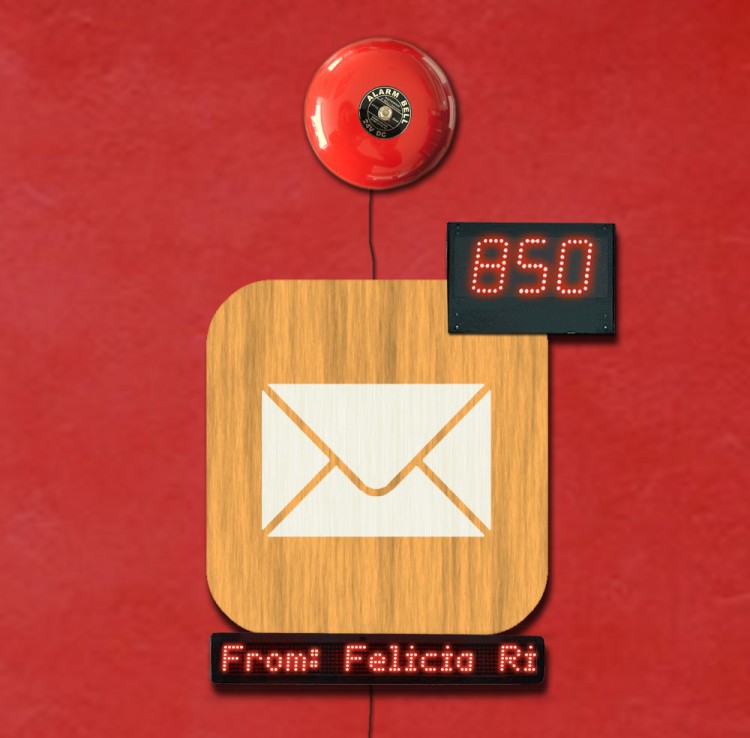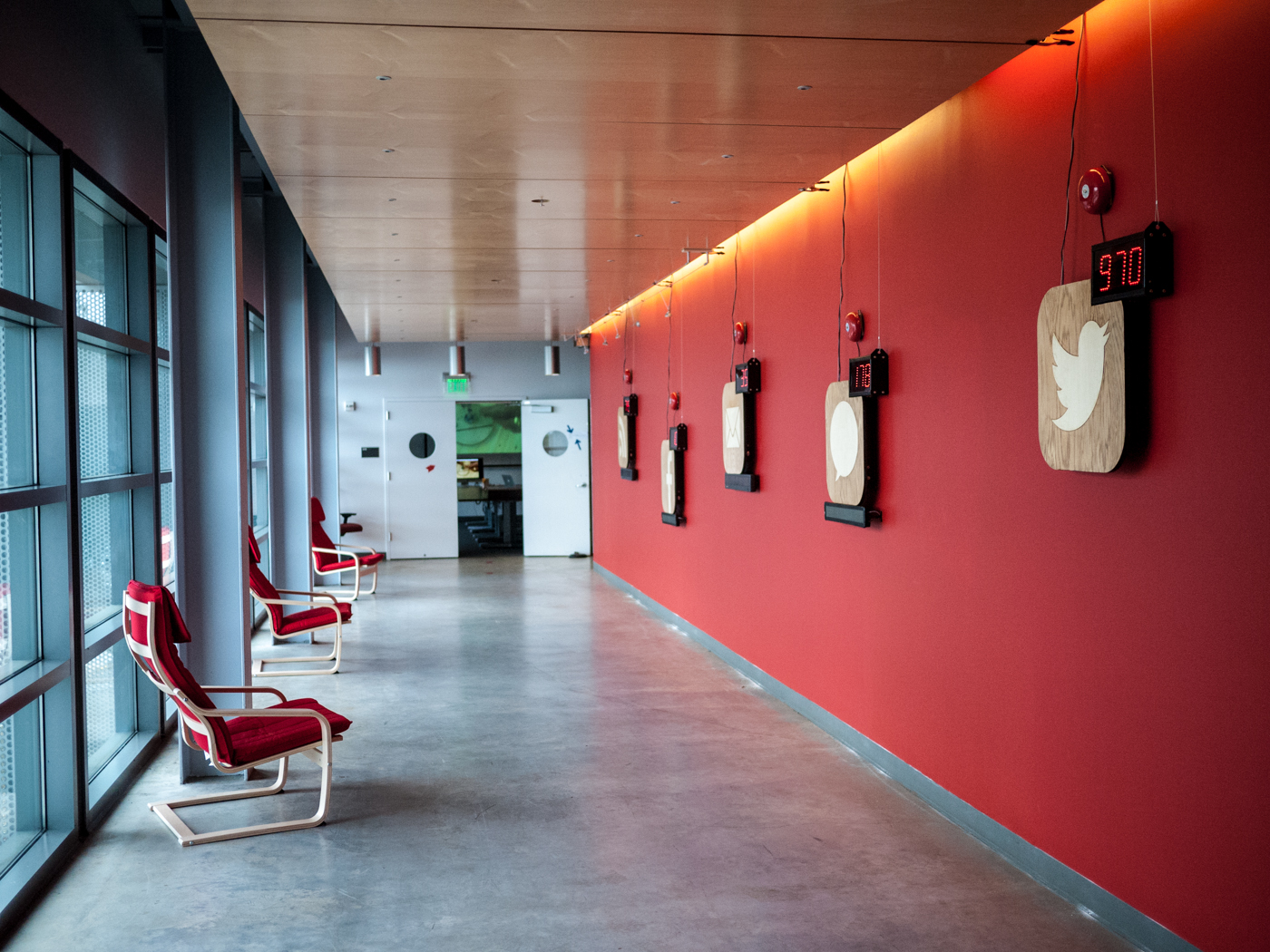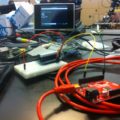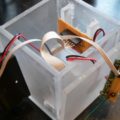An Installation Proposal Toward a MFA in Digital Art and New Media at UCSC
Primary Artist: Wes Modes
Length of Project: 8 Weeks
Proposal version: 1.6
FOMOphobia is a network-connected installation that immerses the viewer in a visualization of the artist’s real-time social networking anxiety, sounding alarms and keeping count of unhandled content.
Like a lot of people, the artist faces a very 21st Century First World Problem: The guilt of not being able to keep up with all the communications from all his devices and social networks. Blog comments, calendar reminders, email, Facebook, Flickr Mail, friend requests, Goodreads, LinkedIn, Instagram, OKCupid, RSS feeds, SMS, Twitter,voicemail, Yelp activity, and on and on. Anxiety over missing important information is termed FOMO, or Fear of Missing Out.
A device was recently featured on Hackaday which displayed one’s unread email count in large glowing letters. It was pitched as a helpful convenience, a clever way to see whether you need to drop everything and check your email. To the artist, it looks like guilt made manifest.
What if we made this social anxiety more visible? What if we made the order to get back to work on constructing your social networking identity loudly explicit?
Like social media itself, FOMOphobia simultaneously attracts and repels. The installation features individual monitors for each of the most prominent social media and comfortable chairs from which to observe the piece. Each monitor consists of a prominent numeric LED counter of the number of unread or unhandled items, paired with a clangorous electric bell that sounds whenever the number increments.
Additionally, a single line LED display scrolls through messages as they are received exposing the content of the artist’s social networking. The artist shares not only his anxiety about accumulating social media, but the very content of that media, creating a captivating vulnerability and striking an empathetic chord with viewers.
Here is a digital concept sketch that shows most of the elements.
Forms and Materials
The installation would consist of discrete modules, one for each form of social media. New monitors could be added with relative ease. Together, they would create an audio-visual manifestation of modern communication angst, an insistent cacophony of social networking.
Each monitor consists of:
- a prominent red or amber LED numeric readout representing the number of unread or unhandled messages,
- a sign (digital or printed) indicating the social media being monitored,
- a audio indicator, in the form of an electric bell or horn, to indicate when the number is incremented
- an optional single line LED text readout to display the contents one line at a time of the incoming message
The current plan calls for a central internet-connected microprocessor to connect to each of the social media sites to get counts and content. This central master unit would connect to slave processors that would increment the counters, display the media contents, and ring bells.
Currently, a Raspberry Pi could serve as the master unit with Tennsy microcontrollers or Arduinos serving as slave units. The numeric and alphanumeric signs have their own processors and accept serial communication for input. A microprocessor-controlled relay can handle the electric bell.
Possibilities abound in the form of social media dashboard for connecting to social networking services without laboriously writing new APIs and screen-scrapers. Some of these include HootSuite, Seesmic, Myweboo, Digsby, and Threadsy. More analysis is needed to determine requirements with which to compare each of these services.
Originally, I considered the possibility of viewers providing their credentials to their own social media so that the system could share the anxiety by reminding them how much social networking they’d left undone. However, by displaying the content of my social media as well as the anxiety about it’s accumulation, rather than providing direct experience to viewers, the installation instead asks for an empathetic reaction from viewers.
The cost of the materials may be more expensive than my modest artist’s budget allows in which case a small grant from an on-campus source may be sought. Though I plan to get many of the materials for the project donated, if possible.
Background Context
Fear Of Missing Out (FOMO) is a recently-recognized form of social anxiety. Wikipedia describes it as “ compulsive concern that one might miss an opportunity for social interaction, a novel experience, profitable investment or other satisfying event. This is especially associated with modern technologies such as mobile phones and social networking services.”
FOMO is present for many of us living lives steeped in 24/7 networked technology and is currently a hotly-discussed topic in the media. Recent articles about FOMA and related stress and anxiety were covered in the New York Times, Oprah, Wall Street Journal, and the Huffington Post.
Wikipedia cites a study by Andrew Przybylski which concludes that “the condition was most common in those who had unsatisfied psychological needs such as wanting to be loved and respected.” The study laid the blame on “social networks such as Facebook and LinkedIn, which provide constant opportunity for comparison of one’s status.”
Hardware Requirements
Control Unit
| Unit | Specifications |
| RaspberryPi Microcontroller | Model B w/ 4GB SD memory ($35) |
Per Monitor
| Unit | Specifications |
| Teensy Microcontroller | Model 3.0 with header pins ($22) |
| Numeric LED Display | 5.5” three digit numeric display, RS232 controlled ($100 – 300) |
| Alpha LED Display | 3” single-line display, RS232 controlled ($200-500) |
| Electric bell | 8” 120v, 24v, or 12v ($25) |
| Relay | 120v, 24v, or 12v to match bell voltage ($5) |
Timeline
Here is a very rough timeline of the project:
Week one: Formalize requirements
Week two: Research hardware that meets requirements
Week three: Order or acquire hardware
Week four: Research software requirements
Week five: Create individual modules
Week six: Create master controller
Week seven: Create connections to social media
Week eight: Connect master controller to individual monitors
Budget
Here is a preliminary budget that does not take donated material into account:
| Qty | Unit | Cost Per | Total |
| 1 | RaspberryPi Microcontroller | 35 | 35 |
| 4 | Teensy Microcontroller | 22 | 88 |
| 4 | Numeric LED Display | 100 | 400 |
| 4 | Alpha LED Display | 200 | 800 |
| 4 | Electric bell | 25 | 100 |
| 4 | Relay | 5 | 20 |
| 4 | Signage | 25 | 100 |
| 1 | Project signage & context | 25 | 25 |
| 1 | Cases, wiring, and misc | 100 | 100 |
| TOTAL | $1668 |
Development costs are minimal since programming and production are part of the artist’s MFA work. There is no expectation of hiring consultant or development help.
Funding Sources
Currently, no resources or monetary support beyond the artist’s personal funds are committed to the project. Possible funding sources include:
- In-kind development support from fellow artists (a modest stipend to support these artists is preferred, if budget allows)
- UCIRA Graduate Grant (up to $5000)
- UCIRA Mini Grant (up to $1000)
- The Awesome Foundation For the Arts and Sciences (up to $1000)
- Crowdsourced IndieGoGo Campaign ($740 of $1668 goal collected)
Conclusion
FOMO is the result of our bombardment by modern networking, more insidious because we take an active part in it, simultaneously stressed out about and perpetuating our own addiction.
FOMOphobia brings this private guilt to the surface with glaring numeric displays and alarm bells. It exposes the artist’s social networking burden and addiction, revealing both the accumulation and content of his social media messages. FOMOphobia provokes viewers to re-weigh the value of their relentless connectedness.
References
Here is an abridged list of sources:
- Smith, Roberta. “ART IN REVIEW; Mark Hansen and Ben Rubin — ‘Listening Post’.” New York Times 2 February 2003, Collections. Print. <http://fffff.at/when-you-dont-own-yourself/>.
- Considine , Austin. “Friend Fracker Tests Your Facebook Friendships by Randomly Deleting Them.” Motherboard. Vice Media, 15 May 2013. Web. 20 Oct. 2013. <http://motherboard.vice.com/blog/friend-fracker-tests-your-facebook-friendships-by-randomly-deleting-them>.
- Miranda, Christine, Ann Mack, et al. Fear of Missing Out. New York: JWTIntelligence, 2011. Print. <http://www.jwtintelligence.com/trendletters2>.
- Wortham, J. “Feel Like a Wallflower? Maybe It’s Your Facebook Wall.” New York Times 9 April 2011, New York Edition BU3. Print. <http://www.nytimes.com/2011/04/10/business/10ping.html>.
- Heyman, Marshall. “Right Place at the Right Time.” Wall Street Journal 9 September 2013, New York Edition n. pag. Print. <http://online.wsj.com/article/SB10001424127887324549004579065410628456636.html>
- Przybylski, A.K., K. Murayama, et al. “Motivational, emotional, and behavioral correlates of fear of missing out.” Computers in Human Behavior. 29 1841-1848. Print.
- Cohen, Claire . “FoMo: Do you have a Fear of Missing Out?.” The Daily Telegraph [London] 16 May 2013, Women’s Life. Print. <http://www.telegraph.co.uk/women/womens-life/10061863/FoMo-Do-you-have-a-Fear-of-Missing-Out.html>.
- Kelner, S. “Is FOMO depriving us of our ability to exist in the present and take pleasure in the here and now?.” Guardian [London] 13 January 2013, Comment. Print. <http://www.independent.co.uk/voices/comment/is-fomo-depriving-us-of-our-ability-to-exist-in-the-present-and-take-pleasure-in-the-here-and-now-8449677.html>.






One thought on “FOMOphobia: An Insistent Social Networking Anxiety Monitor”